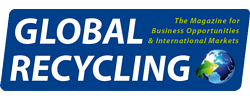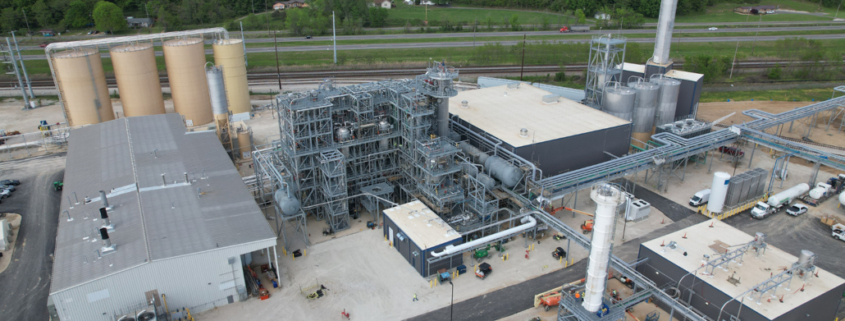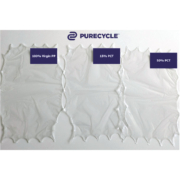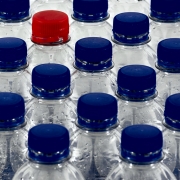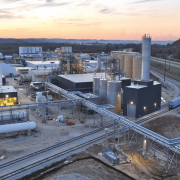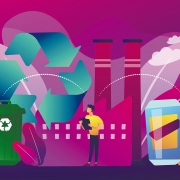PureCycle Has Big Plans for the Future
American company PureCycle Technologies LLC., a subsidiary of PureCycle Technologies, Inc., holds a global license for the patented dissolution recycling technology (developed by The Procter & Gamble Company) designed to transform polypropylene plastic waste (designated as #5 plastic) into a continuously renewable resource. The purification process removes color, odor, and other impurities from this plastic waste, resulting in its PureFive resin “that can be recycled and reused multiple times, changing our relationship with plastic”.
In an interview with GLOBAL RECYCLING, PureCycle CEO Dustin Olson explained the recycling process and its prospects regarding international polypropylene recycling.
PureCycle’s solvent-based purification process represents a novel approach to recycling polypropylene. How does this technology differ from conventional mechanical recycling methods, and what are the key advantages in terms of material quality and application potential?
Plastic recycling has been around for decades, but mechanical methods produce a recycled product that often comes with a handful of trade-offs, including unpleasant odors, unreliable performance, high scrap rates, limited colorability – and, most importantly, fewer end-use applications.
At PureCycle, we have a groundbreaking, patented process for recycling polypropylene. Through a form of dissolution recycling, we remove color, odor, additives, and other plastics from waste polypropylene. Dissolution is a physical process, not a chemical process. Plastic waste is shredded and mixed with a proprietary solvent that selectively dissolves the polypropylene, separating it from the other materials. Unlike traditional mechanical recycling, which degrades plastic quality over time, this process produces an ultra-pure recycled resin that looks, feels, and performs like virgin plastic. Additionally, our dissolution recycling process is more environmentally friendly with a lower carbon footprint than new plastic production. This allows our customers to meet their sustainability goals without compromising on quality or performance in applications such as BOPP film, fiber, thermoforming, or injection molding. In short, our process helps close the loop on plastic waste while making recycled polypropylene more accessible at scale.
Your flagship plant in Ironton has begun delivering initial product volumes. What technical or operational insights have you gained since start-up?
As with any novel technology, when commissioning and reviewing early operational data, several key learnings emerged that have driven multiple upgrades to our business operations. Feedstock quality from MRF’s was an early challenge that we have addressed through the creation and ongoing operations at our Denver, PA sorting facility and several key upgrades at Ironton. The Denver facility has allowed PureCycle to increase the percentage of polypropylene in feedstock bales being sent to Ironton to greater than 95 percent. With these higher-percentage feedstock bales, we can operate Ironton more efficiently.
During 2024, we decided to expand our commercial operations by introducing compounding. By adding compounding into our product creation process, PureCycle has been able to introduce a wide range of resin grades that include varying amounts of recycled content. The decision to add compounding has allowed us to expand the applicability of our PureFive resin and expedite the timeline of customer trials.
In 2025, we have furthered our investment in compounding by deciding to vertically integrate compounding at our Ironton Facility. We anticipate this expansion to be completed by the end of 2025 and can provide approximately 100 million pounds of annual compounding capacity onsite. Additionally, we anticipate this decision to have sustainability benefits and eliminate approximately four million US-Dollar of annualized third-party costs currently associated with compounding our PureFive Choice resin.
Which end-use markets or applications are you currently prioritizing for the rollout of PureFive, and what feedback have you received from early industrial trials, particularly in the film, fiber, or food packaging sectors?
We’re seeing strong interest in our PureFive resins across a variety of end-use markets. This includes applications in fiber, film, packaging, and consumer goods, where demand for high-quality recycled polypropylene continues to outpace supply. Approximately 20 percent of the global virgin polypropylene (PP) supply is used for fiber. Until now, there has not been a reliable recycling alternative to replace virgin PP due to the complexity of the fiber operations. Earlier this year, we completed a sale to Drake Extrusion, the leading producer of fiber and yarn in North America, after they successfully tested our resin across multiple fiber types. That agreement marked a turning point for us and has already accelerated commercial conversations across the broader fiber industry. We’re also partnering with Emerald Carpets to bring circularity to the trade show space. They’ve signed a commercial supply agreement for approximately five million pounds.
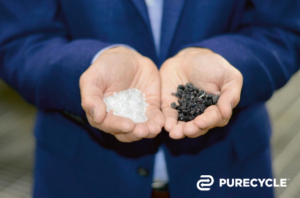 The packaging sector is another priority. We’ve advanced to scaled production trials with P&G for spout and dose caps on select bottles of Procter & Gamble products, and we expect to see those products on shelves in early 2026. That’s a major milestone, not just for us, but for the industry, proving that our resin can meet the technical and aesthetic standards of some of the world’s most recognizable brands.
The packaging sector is another priority. We’ve advanced to scaled production trials with P&G for spout and dose caps on select bottles of Procter & Gamble products, and we expect to see those products on shelves in early 2026. That’s a major milestone, not just for us, but for the industry, proving that our resin can meet the technical and aesthetic standards of some of the world’s most recognizable brands.
We’ve also worked with Churchill Container to launch their Run It Back line of souvenir cups and buckets that contain up to 100 percent post-consumer recycled content. The Run It Back line is available to professional and collegiate sports teams looking to introduce sustainable souvenir items for their fans in 2025, and we’ve already gotten interest from several major sports teams. Earlier this month, we announced that the Cleveland Browns, a professional American football team, will use 100 percent PureFive resin in their 2025 line of player souvenir cups.
Compounding has played a key role in accelerating these efforts. It allows us to tailor our PureFive Choice resin for specific applications and bring it to the market faster. We’ve had early success in the automotive space with trials showing that our resin performs well in demanding applications like bumper fascias. Polypropylene is the most widely used plastic in automotive applications, with an average of around 100 pounds per passenger car, so the automotive industry represents a large opportunity for us. Across a majority of the trials, the feedback has been clear: our PureFive resins perform like virgin polypropylene, but with the sustainability advantages of a post-consumer recycled material. That’s what the market has been waiting for, and that’s what sets us apart.
PureCycle recently announced a 300 million US-Dollar capital raise to support expansion in Asia, Europe, and the U.S. Can you share more about how this funding will accelerate your global rollout strategy – and what makes regions like Thailand and Europe particularly attractive for high-capacity polypropylene recycling investments?
The recent 300 million US-Dollar capital raise is a pivotal step in accelerating our global growth strategy and brings us closer to achieving our goal of one billion pounds of installed capacity by 2030 across the U.S., Europe, and Asia. This capital enables us to move ahead on high-impact projects, including a 130-million-pound line in Thailand in partnership with IRPC, a Petrochemical Company based in Thailand, and another 130-million-pound line in the NextGen District at the Port of Antwerp, Belgium. Both locations offer mature feedstock streams, strong infrastructure, and low-risk expansion opportunities. In Thailand specifically, we’re leveraging IRPC’s local expertise and infrastructure to bring the facility online more quickly and cost-effectively. In Antwerp, being co-located with other circular economy innovators allows us to collaborate and create operational efficiencies from day one.
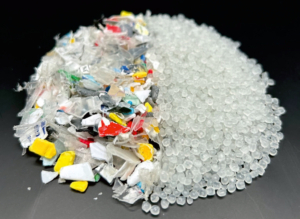 We’re also applying everything we’ve learned from Ironton to enhance the next U.S. facility, planned for Augusta, Georgia, where we intend to build a Gen 2 line with a capacity of over 300 million pounds annually. The capital raise gives us the flexibility to execute these builds quickly and efficiently, bringing our product to more markets around the world.
We’re also applying everything we’ve learned from Ironton to enhance the next U.S. facility, planned for Augusta, Georgia, where we intend to build a Gen 2 line with a capacity of over 300 million pounds annually. The capital raise gives us the flexibility to execute these builds quickly and efficiently, bringing our product to more markets around the world.
The upcoming facility in Rayong, Thailand – developed in partnership with IRPC – is set to become a key milestone in your international strategy. How does this collaboration leverage local infrastructure and expertise, and what lessons from Ironton are being applied to ensure a faster, more cost-effective ramp-up?
Thailand is a great opportunity for PureCycle. We’re partnering with IRPC, the first fully integrated petrochemical operator in Southeast Asia. Several of their team members are already being onboarded, bringing local expertise and strong project experience to the expansion. Additionally, IRPC’s existing infrastructure, including a deep-sea port, oil depots, and power plants, will allow PureCycle to leverage this existing site infrastructure to streamline construction costs.
As with all future growth projects, we’re applying key lessons from Ironton and have had third-party engineering groups validate our approach. We expect Thailand to be up and running before any other facilities in our pipeline.
Mr. Olson, thank you for this interview.
(Published in GLOBAL RECYCLING Magazine 3/2025, Page 14, Photos: PureCycle)
